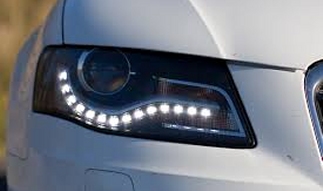Daytime
Running Lights or DRLs and classic car lighting
I
am researching these topics for an article and would welcome your views.
See the DRL thread on the V8BB.
V8BB
thread
Posted: 140815

|  | DRLs
and classic car lighting
Since February 2011 Daytime Running Lights or
DRLs have been introduced on all new cars in the European market and are becoming
an increasing feature in our rear view mirrors. The reason put forward for the
introduction of DRLs is "to increase the visual contrast between vehicles
and their background so that the presence of a vehicle is made more obvious to
other road users". Studies that have been carried out by the bodies promoting
DRLs claim that DRLs will make a difference to certain types of accident. Other
groups feel they increase visual glare and tend to mask other road users, particularly
motor cycles. | Are
DRLs also becoming a fashion or car styling item?
Far from being considered
primarily a 'safety feature', many car manufacturers and the motoring press are
treating DRLs as a 'stylish addition' to a car, concentrating on the look of DRLs
as adding character to a car rather than contributing to its safety. So with brands
like Audi the DRLs take on the form of "surprised eyebrows" in your
rear view mirror conveying a degree of assertiveness which some drivers feel uncomfortable
with reminding them of that classic BMW advert from the early 70s with a BMW in
the rear view mirror and the strapline below - "move over!".
Are
DRLs too bright?
Some groups that have commented on DRLs are particularly
worried that the European standards that have been introduced are too powerful
for our normal use and that the lights on current cars, particularly new cars,
are now far too bright to be safe. The regulations (ECE Regulation 87, Revision
2: Daytime running lamps) are clear in terms of the specification of the light
(brightness and angles, construction and approval) and the use (to make the vehicle
more easily visible when driving during daytime). The standard stipulates that
the direction of these lights is to be fixed to point directly in front of the
vehicle unlike dipped headlights that are aimed so as not to dazzle the oncoming
driver. Now consider that the light levels specified for DRLs are between 400cd
and a maximum of 1200cd. To give a comparative reference level for this amount
of light, dipped headlights are typically around 800cd - and these are by law
aimed down and away from oncoming traffic. Therefore, with current legislation,
DRLs can actually be brighter than dipped headlights but without the beam pattern
that prevents dipped headlights from dazzling oncoming road users.
Comparative
lighting standards are the key issue
When you are on the road as a driver,
or indeed as a pedestrian, to be able to see cars ahead, behind and to the side
of you is essentially an exercise where the eye scans the scene and identifies
vehicles, motor bikes, cycles and pedestrians. With a generally even standard
of identification in terms of lighting, the whole range of vehicles can be easily
seen but once a group of vehicles has significantly brighter lighting they, on
a comparative basis, tend to attract your eye more and the contrast between the
brighter daytime lighting and the lower illumination standards of earlier cars
- and in many cases that will mean no illumination in daytime driving conditions
- becomes so great.
Classic car lighting
Many owners of classic
cars built in the 60s, 70s and 80s, and even the 90s in the case of the RV8, have
relatively modest lighting as the original equipment. So most owners of MGBs and
MGBGTV8s have binned the sealed beams and gone for a set of lenses and halogen
bulbs which has transformed the headlights from candle power to near modern standards
of auto lighting. But often the original rear lights are woefully at a low level
of illumination when compared with modern rear lights. So whilst a headlight upgrade
is mainly to aid forward vision at night the essential concern which is increasingly
a matter classic car enthusiasts will have to consider is the relative lighting
standards because that is a major factor in visibility - or the dreadful term
conspicuity is sometimes used - on the road.
What do fellow members feel
about the introduction of DRLs, the growing trend for assertive styles of DRLs
on some new models and the comparative visibility of a classic car in this growing
new situation with far brighter lighting in both day and night conditions? What
lighting upgrades for a classic car like and MGBGTV8 and RV8 do fellow members
feel are necessary or will halogen front headlight upgrades, possibly LED tail
light upgrades together with the use of dipped headlights as DRLs become the norm?
I am researching these topics for an article and would welcome your views. | | V8
Register - MG Car Club - the
leading group for MG V8 enthusiasts at www.v8register.net |
|





